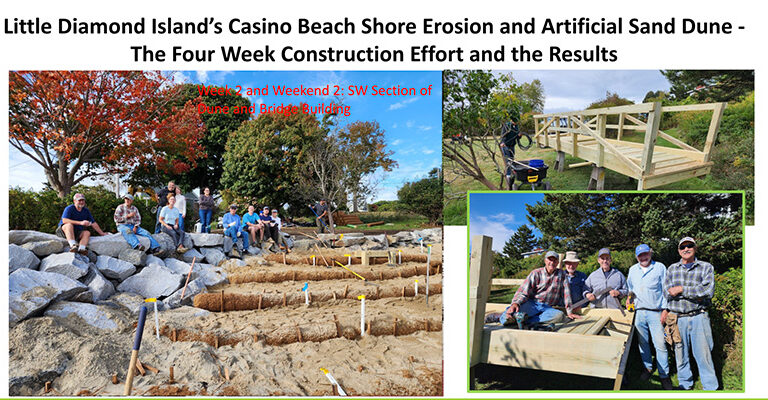Sea level rise will accelerate in the decades ahead, and coastal communities should act now to assess risks and identify solutions for the long term—generations or even a century or more into the future.
That was the message delivered by the keynote speaker at the fourth annual SOS Saco Bay Coastal Conference on Oct. 7.
Cameron Wake, director of the University of New England’s Center for North Atlantic Studies, told attendees that the ocean level has risen about 8 inches in Portland Harbor since 1912. By 2100, the level is projected to rise even more, from 1.6 feet on the low end to close to 9 feet on the high end, Wake said.
“At any given dock there’s likely to be more water in terms of depth in the future.”
When looking ahead, people along Maine’s coast should imagine what their communities might look like with 10 feet of sea level rise, he said. Under that scenario, people should ask themselves: What does a resilient coastal community look like? What does a working waterfront look like? What does access to the ocean look like?
“Even given the enormous challenges of protecting our coastal areas so our residents can be in their homes for as long as possible, we need to prepare for the inevitable, which is many feet of sea level rise in the future that’s going to require an entirely different response,” Wake said after his presentation. “I understand there are the near-term challenges that are going to occupy people’s attention, but we need start inserting in those discussions the longer-term challenges, which I think are going to require a transformation of the way we think of the coast and build on the coast and live on the coast.”
Save Our Shores (SOS) Saco Bay is a nonprofit advocacy group that works to preserve and restore the shoreline along Saco Bay. Close to 200 people attended this year’s conference, including municipal and state planners, representatives from nonprofit organizations, college students, and members of the public.
The all-day event at the Ferry Beach Retreat & Conference Center featured classroom sessions, a trade show, and outdoor field stations on the beach. One track focused on coastal resilience, particularly in the face of rising oceans.
Sea levels are on the rise primarily due to increased global carbon dioxide emissions that have warmed the planet, and the melting of massive ice sheets and glaciers in Greenland and Antarctica, Wake said.
The combination of rising seas and a warming climate has made Maine susceptible to more frequent coastal flooding. That vulnerability was fully exposed in January 2024 when two vicious storms in four days caused widespread destruction and damage from Kittery to Eastport. They destroyed fishing wharves, damaged and flooded oceanside homes, swamped neighborhoods, demolished roadways, eroded beaches, and swept old fishing shacks and other structures out to sea.
In the wake of those storms, one of the pressing concerns has been the impact to the state’s working waterfronts, which fishermen and other commercial interests rely on for their livelihoods.
Coastal towns have a variety of strategic approaches at their disposal to help them transition or transform in response to the threat of sea level rise and increasingly violent storms. Those strategies, outlined during a panel discussion on coastal resilience, are:
- Protecting (keeping water away from homes)
- Accommodating (elevating buildings and infrastructure to allow higher water to pass through)
- Avoiding (preventing new development in hazardous areas)
- And retreating (removing or relocating critical infrastructure away from danger)
The panel discussed whether some sort of property buyout program would be appropriate for Maine to purchase homes that have been damaged by or are at risk from coastal storms. Similar programs have been implemented elsewhere in the country, but there are many questions about whether buyouts should be considered in Maine.
It’s important that any decisions on buyout programs—and the cultural, economic, and social implications of such programs—should come from community members themselves, panelists said.
“This is not a strategy that should be done top down,” said panel moderator Jessica Brunacini, a coastal resilience expert at the Wells National Estuarine Reserve.
During a presentation on communicating the impact of Maine’s changing climate, News Center Maine meteorologist Ryan Breton said plenty of people were climate change skeptics a decade ago. But nowadays, he said, people he talks to are more interested in learning how the changing climate is affecting the weather rather than expressing doubts about climate change.
It’s uncertain exactly how fast sea levels will rise in the future, and it’s hard to say how towns will transform in response to higher oceans, Wake said. Some places will have to explore bold measures around housing, flexible infrastructure, and ocean access.
At the same time, rising sea levels might open up new opportunities for Maine’s working waterfronts, he added.
“The opportunity I see is there’s going to be more water,” Wake said. “How we address that opportunity I think is a discussion we want to open up. I don’t have the answers, but at any given dock there’s likely to be more water in terms of depth in the future. The challenge is going to be do we build higher docks? Do we build higher wharves? How do we get people to and from the waterfront? Where do people live and work along the waterfront?
“There are a lot of challenges, but I also think along the way there might be some new opportunities.”
Clarke Canfield is a former reporter for the Portland Press Herald and the Associated Press. He lives in South Portland.





